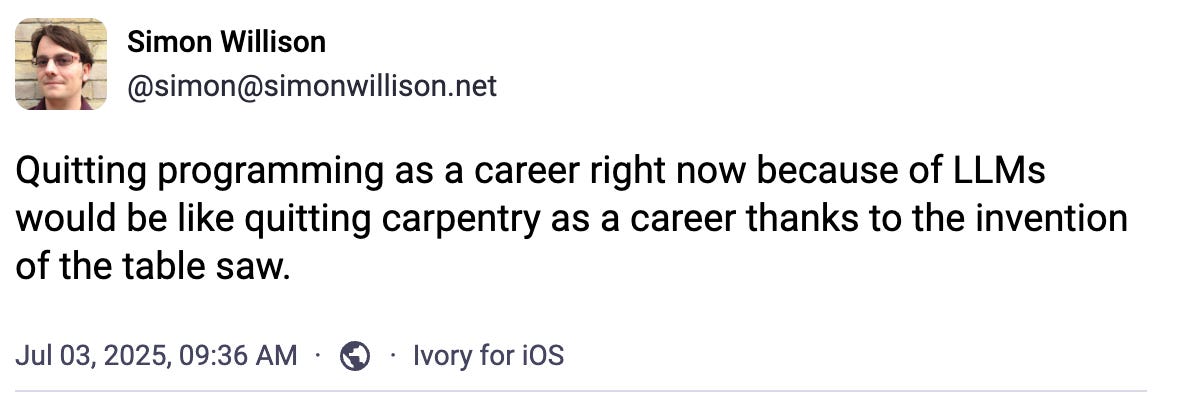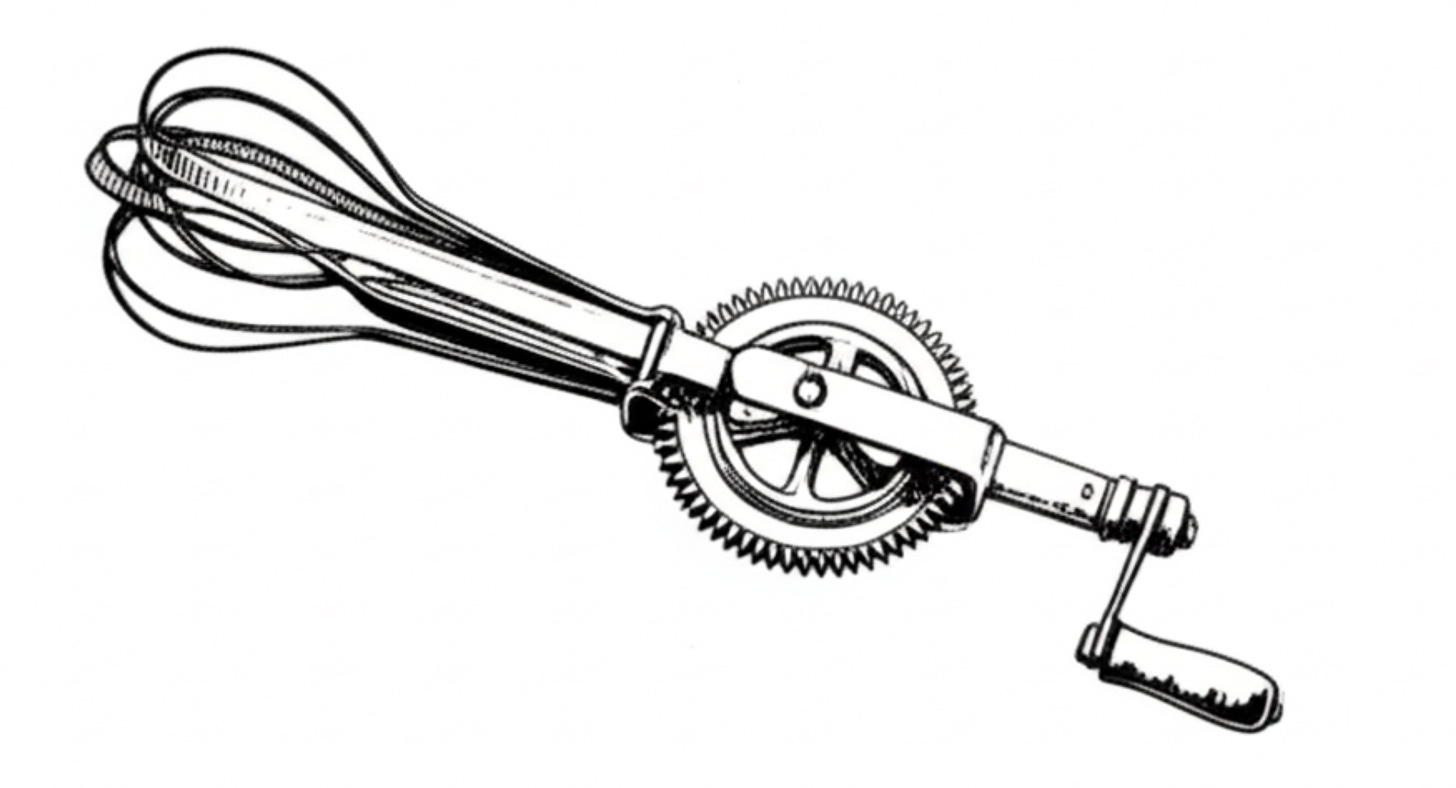Where Are All the Soufflés?
Why AI won't give us better software, just more of it.

The headlines promise revolution. AI tools like Cursor and GitHub Copilot are slashing software development time from days to hours. Aravind Srinivas, CEO of Perplexity, claims these tools cut his engineers' task completion time from "three or four days to one hour." The speed, he says, is "scary."
The promise is intoxicating: AI will automate tedious programming tasks, freeing developers for higher-level creative work. We'll build software faster, cheaper, with fewer bugs. Companies will save millions. Programmers will become more productive than ever.
But what will all these newly productive programmers actually work on?
The optimistic response is predictable. "Don't worry!" they say. "Now that coding is easier, there will be so much more software to build. More apps, more features, more digital experiences. The demand is infinite!"
Simon Willison, a popular open-source developer, puts it this way: "Quitting programming as a career right now because of LLMs would be like quitting carpentry as a career thanks to the invention of the table saw."
I've heard this story before.
I've even written about this story before.
The underlying pattern is Jevons Paradox—the counterintuitive phenomenon where making something more efficient increases total consumption rather than reducing it. More efficient steam engines led to more coal consumption, not less. Better highways create more traffic. Cheaper ride-sharing generates more rides.
But something has been bugging me about this optimistic narrative. Sure, efficiency gains create new demand. But won't that demand eventually hit a natural ceiling?
Let's look at an automation from the 19th century that changed what was possible with an egg. But first we'll have to travel to France.
The Soufflé Revolution
Before there were soufflés, there were cooks laboriously whisking egg whites by hand. Picture a French kitchen in the mid-1800s: a chef bent over a copper bowl, whisk in hand, beating eggs for what felt like an eternity. The process was exhausting, time-consuming, and required perfect timing. Most importantly, it limited what was possible in the kitchen.
Then came the eggbeater.
The mechanical eggbeater, patented in the 1850s, was a marvel of efficiency. What once took a cook twenty minutes of vigorous whisking could now be accomplished in a fraction of the time. Suddenly, the stiff peaks necessary for a proper soufflé were within reach of any kitchen.
And that's when something interesting happened. The soufflé—that "glorious and exciting finish to a great meal," as Julia Child would later call it—became the epitome of French cooking. The dish that had been nearly impossible to execute consistently was now the standard by which fine dining was measured.
The eggbeater didn't eliminate work in the kitchen. It created new expectations.
The Limits of Infinite Demand
At first, the eggbeater story seems to confirm the optimists. Make egg-beating easier, get more elaborate desserts. Efficiency creates new demand—classic Jevons Paradox.
But even rising expectations hit natural limits. You can only eat so many soufflés. There are still just three meals in a day. The washing machine enabled more frequent washing, but you can't wash clothes more than once before wearing them.
So what happens to efficiency gains when demand bumps up against these biological and practical ceilings? Where does the genuinely saved time go then?
Derek Thompson, a writer who has extensively studied American social trends, found the answer in data from the American Time Use Survey. Between the 1960s and 1990s, the average American gained 300 hours of leisure time per year—nearly eight full work weeks of newfound freedom.
The Attention Economy
But, where did those 300 hours go? They were absorbed by increasingly sophisticated forms of entertainment and distraction.
First, television absorbed our newfound leisure time. Thompson notes how TV privatized entertainment, moving social activities from public spaces into living rooms. Americans began spending their saved hours watching screens instead of gathering with neighbors.
Then smartphones privatized attention itself. Suddenly, every spare moment—waiting in line, riding elevators, even walking down the street—became an opportunity for digital stimulation. Infinite scroll, autoplay videos, push notifications. The technology evolved to capture not just our leisure time, but every fragment of mental downtime.
We're not spending our saved hours on hobbies or relationships. We're spending them consuming digital content engineered to be irresistible.
This created an entirely new economy where attention became the most valuable resource. Our biggest companies—Google, Meta—don't primarily sell products. They sell access to human attention. Even Amazon, which we think of as an e-commerce company, generated $56 billion in advertising revenue in 2024, making it the third-largest ad company in the world.
Turns out attention is the most valuable resource.
Weapons of Mass Distraction
This brings us back to AI and software development. Yes, AI tools will make coding more efficient. And yes, some of that efficiency will create new "soufflés"—more sophisticated applications, better user interfaces, more personalized experiences.
But there's a limit to how much useful software we actually need. How many productivity apps can one person use? How many different spreadsheets or word processors can they realistically adopt?
I suspect software will follow the same path as media—and media gives us a roadmap for what happens when production costs plummet.
Consider how content has evolved. Early films were substantial affairs: feature-length stories that provided a canvas for detailed narratives. Audiences had the attention span to sit through two-hour epics because there were only a handful of options. The scarcity of content meant each piece could be substantial, educational, even transformative.
But as production costs dropped and options multiplied, something shifted. With endless content available, audiences developed less patience for lengthy formats. Content naturally evolved to match: we moved from feature films to television episodes, then to YouTube videos, then to TikTok clips. Each iteration became shorter, designed to work with our increasingly fragmented attention rather than against it.
In 1930, Hollywood released about 500 films. Today, with digital tools making production cheaper, over 20 million videos are uploaded to YouTube every day. The efficiency gains didn't create 500 better movies—they created millions of bite-sized pieces of content competing for our attention.
The same transformation is likely coming for software.
The massive platforms will remain—just as feature films still exist alongside TikTok. Enterprise software suites and complex applications that took years to build and deploy aren't disappearing. But the new software will follow the same pattern as media: shorter formats, easier to use, more engaging, more dynamic. Instead of comprehensive packages that do everything, we'll get micro-apps designed to capture moments of attention rather than hours of focused work.





This is a terrific perspective as always. So we might say that Zen is a tiny, personal act of resistance, reclaiming a measure of our attention for ourselves? It is beyond the reach of the many forces commodifying our attention for profit.